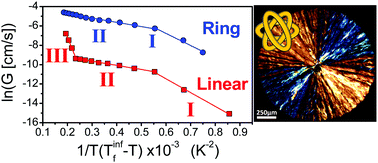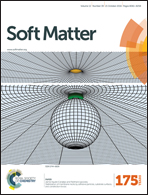Influence of chain topology on polymer crystallization: poly(ethylene oxide) (PEO) rings vs. linear chains†
Abstract
The absence of entanglements, the more compact structure and the faster diffusion in melts of cyclic poly(ethylene oxide) (PEO) chains have consequences on their crystallization behavior at the lamellar and spherulitic length scales. Rings with molecular weight below the entanglement molecular weight (M < Me), attain the equilibrium configuration composed from twice-folded chains with a lamellar periodicity that is half of the corresponding linear chains. Rings with M > Me undergo distinct step-like conformational changes to a crystalline lamellar with the equilibrium configuration. Rings melt from this configuration in the absence of crystal thickening in sharp contrast to linear chains. In general, rings more easily attain their extended equilibrium configuration due to strained segments and the absence of entanglements. In addition, rings have a higher equilibrium melting temperature. At the level of the spherulitic superstructure, growth rates are much faster for rings reflecting the faster diffusion and more compact structure. With respect to the segmental dynamics in their semi-crystalline state, ring PEOs with a steepness index of ∼34 form some of the “strongest” glasses.


 Please wait while we load your content...
Please wait while we load your content...